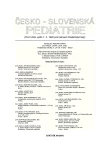Neonatal Diabetes Mellitus Caused by Activation Mutation in the Gene Encoding the Kir6.2 Subunit of Potassium Channel: Is Insulindependency Inevitably Life-long?
Authors:
Z. Šumník 1; Š. Průhová 2; S. Koloušková 1; O. Cinek 1; J. Lebl 2; J. Vavřinec 1; A. T. Hattersley 3
Authors‘ workplace:
Pediatrická klinika 2. LF UK a FN Motol, Praha
přednosta prof. MUDr. J. Vavřinec, CSc.
1; Klinika dětí a dorostu 3. LF UK a FN Královské Vinohrady, Praha
přednosta prof. MUDr. J. Lebl, CSc.
2; Institute of Biomedical and Clinical Science, Peninsula Medical School, Exeter, Velká Británie
3
Published in:
Čes-slov Pediat 2005; 60 (6): 332-337.
Category:
Original Papers
Overview
Introduction:
Permanent neonatal diabetes mellitus (PNDM) is a rare disorder of heterogeneous aetiology. Activating mutations in the KCNJ11 gene encoding the Kir6.2 subunit of ATPsensitive potassium channel were recently described as one of the causes of PNDM. As KCNJ11 is expressed in muscle, brain and heart as well as beta-cells there could be diverse phenotypic expressions. Some patients with KCNJ11 mutations have no extra-pancreatic features and respond to sulphonylureas.
Patients:
Authors present three cases with PNDM caused by the heterozygous mutations in KCNJ11: R201H, V59G and Q52R. The child with R201H mutation is characterized by normal psychomotor development and normal phenotype. The other two cases suffer from very similar neurological symptoms: apart from insulin-dependent PNDM and low birth weight, all had a marked developmental delay, muscle weakness and epilepsy, which did not result from diabetes and/or its treatment. Their physical appearance is characterized by down turned mouth, bilateral ptosis and limb contractures. The patient with the most severe motor delay (Q52R) died at the age of 1.2 year. The patient with PNDM caused by R201H mutation did secrete insulin in response to sulphonylurea and he can discontinue insulin. Authors observed no change either in insulin requirement, diabetes control or neurological/developmental status 12 months after adding sulphonylurea to insulin therapy in subject with neurological symptoms carying V59G.
Conclusion:
In conclusion, a subgroup of subjects can be differentiated among patients with PNDM caused by activating mutations in the KCNJ11 gene, which respond to sulphonylurea treatment. The patients with KCNJ11 mutations and neurological symptoms may represent functionally more severe activating mutations of KCNJ11 that do not respond to sulphonylureas.
Key words:
permanent neonatal diabetes mellitus, Kir6.2, sulphonylurea
Labels
Neonatology Paediatrics General practitioner for children and adolescentsArticle was published in
Czech-Slovak Pediatrics

2005 Issue 6
Most read in this issue
- Relation of Sexual and Skeletal Maturity Assessment to Biological Age in Pediatric Practice
- Growth and Final Height in Girls with Central Precocious Puberty after Long-term Treatment with Depot Gonadoliberin Analogue
- Prediction and Prevention of Type 1 Diabetes Mellitus
- Homozygous Form of Familial Defect of Apo B-100 (FDB) in a 7-Year Girl
